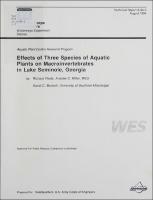Please use this identifier to cite or link to this item:
https://hdl.handle.net/11681/6399| Title: | Effects of three species of aquatic plants on macroinvertebrates in Lake Seminole, Georgia |
| Authors: | Miller, Andrew C. Beckett, David C. Peets, Richard |
| Keywords: | Aquatic macrophytes Aquatic habitats Aquatic ecology Habitat value Seminole, Lake (Ga. and Fla.) Macroinvertebrates Aquatic plants Aquatic Plant Control Research Program (U.S.) |
| Publisher: | U.S. Army Engineer Waterways Experiment Station |
| Series/Report no.: | Technical Report (Aquatic Plant Control Research Program (U.S.)) ; no.Technical Report A-94-5 |
| Abstract: | In July 1987, entire plant samples and quantitative total substratum samples were collected in Lake Seminole, Florida, to analyze the effects of three species of plants (Hydrilla verticillata, Potamogeton nodosus, and Nymphaea odorata) on macroinvertebrate density and community composition. The study was designed to examine epiphytic (attached to plant surfaces) as well as benthic organisms (living on or just beneath the sediment surface). Fifteen macroinvertebrate taxonomic groups were identified from four different habitat types in Lake Seminole. Mean total macroinvertebrate density was greatest in sediments in the nonvegetated cove (4,638.0 individuals/square meter) and least in sediments beneath H. verticillata (1,480.2 individuals/square meter). Oligochaeta and Chironomidae had the greatest taxa richness of all groups present; a total of nine oligochaete and 14 chironomid taxa were identified. The only bivalve mollusc identified was the Asian clam Corbicula fluminea, and only two genera of gastropods were collected (Gyraulus sp. and Physa sp.). Duncan's multiple range test revealed that chironomid density in H. verticillata (197 individuals/square meter) was significantly less than density in the nonvegetated cove (1,315 individuals/square meter) and nonvegetated littoral zone (953 individuals/square meter). A total of 16 taxonomic groups were identified on three species of macrophytes in Lake Seminole. Total macroinvertebrate density was greatest on H. verticillata (12,855 individuals/square meter) and least on N. odorata (5,931 individuals/square meter). Fourteen taxonomic groups were common to the stems and leaves of these three macrophyte species and the benthic sediments. There were significant positive correlations (P < 0.05) between plant surface area and total density for nine macroinvertebrate groups. Chironomids were positively correlated to the surface area of H. verticillata but negatively correlated to surface area of P. nodosus (-0.82). Densities of Hydracarina and Ostracoda were negatively correlated to surface area of Hydrilla (-0.71 and -0.70, respectively). Each plant species had a specific and characteristic macroinvertebrate fauna, regardless of where it was physically located. |
| Description: | Technical Report |
| Gov't Doc #: | Technical Report A-94-5 |
| Rights: | Approved for public release; distribution is unlimited |
| URI: | http://hdl.handle.net/11681/6399 |
| Appears in Collections: | Technical Report |
Files in This Item:
| File | Description | Size | Format | |
|---|---|---|---|---|
| TR-A-94-5.pdf | Technical Report A-94-5 | 9.46 MB | Adobe PDF |  View/Open |